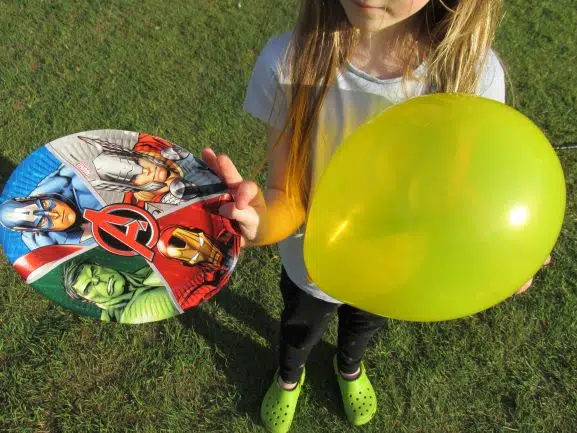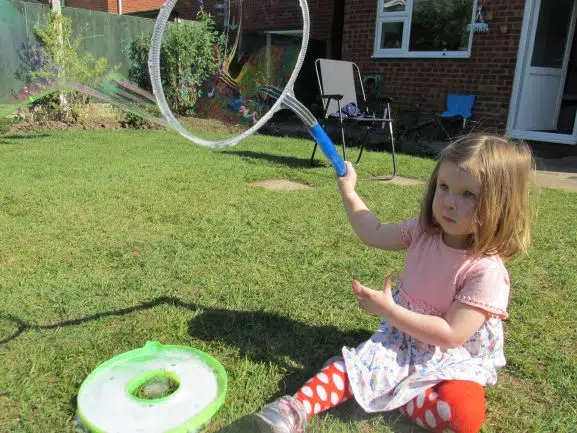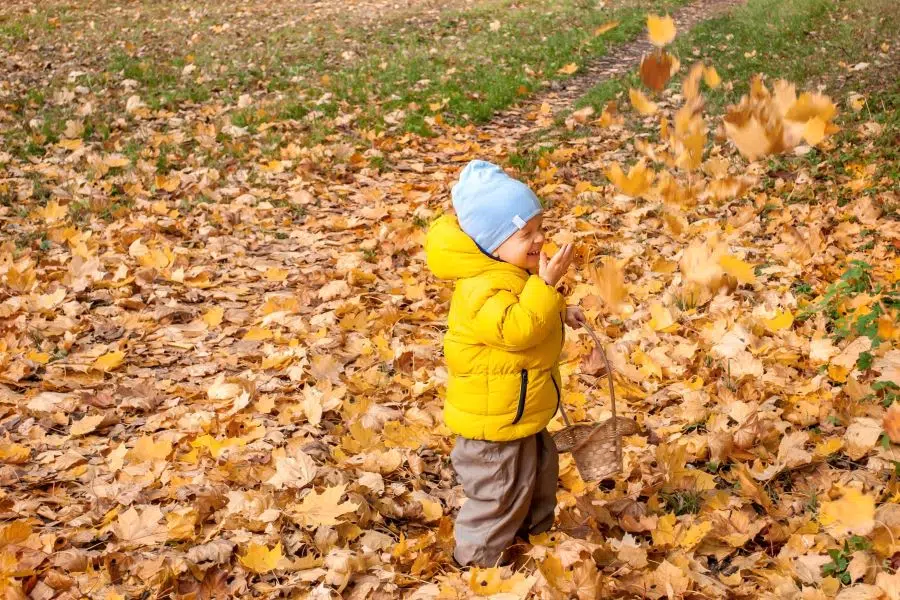Have you ever tried playing throwing and catching with a pre-schooler?
If you have, chances are, they weren’t very coordinated. It’s only to be expected and certainly nothing to worry about!
There are plenty of ways you can help them to throw more accurately and catch more easily.
Start slow and easy!
In my 20+ years of teaching in early education, I’ve come up with a whole host of top tips and games to help young children experience throwing and catching.
You need to think outside the box – so ditch the balls, and try balloons, scarves, leaves, bubbles, and everything else that is floaty and easier to catch! (at least to start with)
In this post, I’ll take you through the ultimate 24 throwing and catching games for preschoolers.

1. Use Balloons To Start With
This really is a golden tip to help practice catching skills!
Balloons are a brilliant way to start throwing to one another as they move at a slower pace than balls, so young children have a longer reaction time.
Provide lots of balloons and children will start to throw and catch naturally.
Encourage them to throw them up in the air as high as they can, then watch them float down. See if they can throw them to their friends or see how far across the room they can get the balloon to travel.
Here are a few more balloon games you can try.
2. Balloon Tennis
One of the most fun catching games, this can be played in a group of anything from two to six players.
The kids stand together in a group facing each other. Have one balloon per team.
The first person hits the balloon up into the air. Then another person tries to hit it up.
The idea is to work as a team, and not let the balloon hit the floor!
3. Plate Rackets
This is pretty much the same idea as balloon tennis, only this time you use paper plates for rackets.
The idea of using paper plates is that they are safe. Even if the kids hit each other (which may very well happen), then it should be pretty much injury-free.
The children work as a team whacking the balloon up into the air with the plates.
4. Multi-Balloon Whack
This is a much trickier game, so only attempt this if the children have gotten really good at the Plate Rackets game.
The idea this time is to have lots of balloons.
Start with one balloon, and help each other to hit it up into the air.
But then add another balloon to the mix, so there are two going at the same time. Then a third…then a fourth…
Basically, see how many they can do before the whole thing falls to pieces! This is a really funny game and a great team-builder.
5. Balloon Count Tennis
This game merges hitting balloons with some simple math.
Have one balloon again, and the children stand in a circle. The first person to hit the balloon says, ‘One’ as they strike it.
The next person hits it and says, ‘Two!’ And just keep going like this!
With older children, you can try counting in different ways – for example counting backward, or counting in tens or twos.
6. Thank You Catch
This is a beautiful way to practice manners, as well as accurate throwing skills.
Have a team of players, and one balloon again.
The first person says someone’s name and throws the balloon at them. That person says, ‘Thank you.’
Then they say someone else’s name and throw the balloon at them, and keep going like this!
7. Bubble Pop
Bubble pop is one of the most exciting catching games, especially because most preschoolers are fascinated by bubbles.
Blow a stream of bubbles and see if they can jump up and pop them.
If you have a bubble machine, even better. Try not to let any land on the floor.
Children can also create bubbles using bubble wands, and run around trying to catch or pop the bubbles that they create.

8. Pop Count
This is such an easy to learn game yet super fun!
As the bubbles pop, you could ask them to count how many they can burst in one go.
9. Bubble Net Catch
Another way to introduce hand-eye coordination is to try and catch bubbles in a butterfly net. This really encourages the children to watch the bubbles and aim their nets.
Although most bubbles will pop, you will be surprised that the odd one actually can be caught!
10. Floaty Scarves
Chiffon scarves or a similar silky material are brilliant for practicing catching skills with pre-schoolers.
Throw the scarves as high in the air as you can and let them float down. Get the children to jump and reach for them.
Try to catch them before they reach the ground.
You can also try strips of ribbons. Provide a basket and if they catch them before they reach the ground, they can place their scarf in the basket.
Count out how many the children manage to catch before they hit the ground.
Floaty scarves game can also no doubt help practice throwing skills in such a fun way.
11. Throwing Leaves
This is a classic throwing game, that lots of children will do naturally around the time of year when there are lots of leaves on the ground.
Certainly one of the best throwing games to play for kids during the fall season!
Throwing and scattering leaves helps the mechanics of learning to throw, and also is of great fascination for children with a trajectory schema.

12. Rolling
Moving on to balls now. With little ones, it’s a good idea to give lots of opportunities for rolling before you even begin to work on throwing.
That way, they can get used to the underarm movement in a more controlled way.
You can practice rolling in lots of different ways.
With very young children you could start by rolling toy cars to one another, then move on to rolling large and small balls to each other.
Skittles are also a brilliant way to encourage rolling skills. Try drawing circles or lines on the floor in chalk and aim to roll a ball into the circle or across the line.
Watching a ball roll towards you is also a good way to encourage that all-important hand-eye coordination, but in a slower more controlled way than throwing it.
Encourage the children to watch and… stop!
13. Throwing
More throwing games!
Once they’ve got the hang of rolling a ball back and to, you can safely move onto underarm throwing.
Practice lots of big arm swings first. Lots of children don’t swing their arms enough when they start to throw, so the ball just drops to the floor.
Try lots of big arm circles to warm up and encourage them to take a step forward as they throw (throw arm forward).
If they can step onto the opposite foot to their throwing arm, their throw will be more accurate but don’t worry too much about technique with very young children.
As long as they are having a go and keeping active, they will learn throwing and catching.
14. Bean Bags
After children have become more confident with catching objects that move slowly (like balloons and bubbles), a good next step is using beanbags.
They are both gentle, but quicker-moving than balloons and the like.
If you don’t have any beanbags, you could try plastic freezer zip bags filled with dried peas or lentils.
15. Up In The Air
We want to encourage pre-schoolers to throw upwards with an underarm motion, rather than overarm.
If you have a high clothesline, try pegging targets on it. You could use different colored socks, gloves, or bulls-eye cards.
Ask the children to try and throw their beanbags upwards to hit the targets.
If they can do this, you can move on to throw a soft ball up in the air, or try airflow balls (plastic balls with holes in).
If they are really good at it, try smaller ping-pong balls for a real challenge.
16. Pairs
Once pre-schoolers have started to get a bit of coordination with throwing upwards, the next step is to try throwing and catching to each other.
Start with balloons again and try to pass a balloon back and forth as many times as you can without dropping it. Count as you throw.
Remember to start counting from the beginning again if you drop it.
17. Target Practice
Most pre-schoolers take a long time to be able to throw with any accuracy and that is perfectly normal and nothing to worry about.
I’ve lost count of the number of balls that have shot off over fences or onto roofs when I’ve been playing catch with young children, and that’s all part of the fun of pre-school. There are lots of ways to encourage children to improve their throwing and catching skills.
Provide containers for the children to throw into. You can be flexible here and use whatever you have to hand. You could try:
- Large and small buckets
- Large tubs or plant pots
- Hoops,
- Chalk circles
- Nets
- Flexi tubs
Try to make sure your container is stable. Add some weight inside it or position it against a wall if you need to.
18. Scoring Games
Once you have a container and some balls, remind the children to roll their arms in an underarm throw and try to get them to land in the container. This is a nice time to encourage stepping forward on the opposite foot as they throw.
You can count up how many balls land in the container at the end of the game or to make it a bit more exciting, try adding a timer and see how many they can get into the container before the time runs out.
You could use a big container and a little container and see how many land in each one.
I always like to have a piece of chalk handy so that I can draw a line the children stand behind before they throw. That way, as they start to improve, you can move the line back a little bit to keep challenging them.
Make sure you give lots of praise and encouragement every time they manage to get the balls into the containers.
There are lots of ways to make targets, other than containers.
Find a wall, away from windows and draw a big chalk circle on it.
If the children can throw the ball into the middle of the circle, divide it in half and see if they can hit each side of the circle. If they can do that, divide it again into quarters.
19. Hoops
Hoops are another way to make a quick target and one of the most exciting throwing games. Either hang a hoop on a hook on a wall or place smaller hoops in a line and let the children roll and throw the balls into the hoops.
You can also tie hoops onto a washing line with a piece of string for a different kind of target. I like to use balloons at first and slowly build up to larger balls. A tennis ball or soft foam ball can also work.
20. Skittles
Keep practicing those underarm circles and one foot forward by playing a good old game of Skittles. Counting out how many Skittles you knock over is brilliant practice for preschoolers.
21. Split Splat Splot
Once your children have gotten the hang of an underarm throw, try this game for some real fun.
Fill a bucket with water and some large sponges. Use the chalk circle or a hoop hanging on the wall as a target and see how many watermarks you can make in the circle by throwing a wet sponge.
Waterproofs are a good idea here!
You can replace the sponges with sponge balls if you have them. You can have lots of fun throwing and catching wet sponges to each other too.
22. Pebble In The Puddles
Another one for throwing practice.
Simply find a good-sized muddy puddle and ask the children to stand a good distance away and try to throw a pebble into the puddle.
Experiment with distance and speed to see who can make the biggest splash or who can get the water to splash up the highest.
23. Goalie
Mark out a goalpost with cones, markers, or whatever you have to hand.
Choose a child to be in goal and give them a pair of special goalie gloves. The bigger the gloves the better. I like to use a pair of big thick oversized gardening gloves for this.
Tell them that they have magic gloves on and they have to save the goals.
Encourage them to spread their fingers really wide and watch the balls as they come towards them and save as many as they can.
Make sure you give them a big cheer, every time they save a goal. If you want to make this easier, you can go back to using balloons or softballs first.
24. Beachball
If you can, blowing up a few large beachballs is a great way to encourage throwing and catching.
Encourage the children to spread their fingers out as wide as they can and start with soft, high throws, aimed right into their hands.
Ask them to throw the beach balls up into the air and try and catch them before playing catch with a friend.
Throwing and catching can be difficult skills for preschoolers to master so provide lots of free time to practice and lots of encouragement when they have a go.
Expect lots of haphazard throwing when they begin and plenty of misses when they try to catch, but don’t give up!
If they throw in a wonky direction or seem to have butter fingers when they’re trying to catch, just praise them for having a try.
Remember the skills:
- Swing your arm
- One step forward
- Stand on the opposite leg to your throwing arm
- Keep your eye on the ball
- Spread your fingers wide
- Keep smiling!!
Sources
A Study on Gross Motor Skills of Preschool Children, Joanne Hui-Tzu Wang Source
Are gross motor skills and sports participation related in children with intellectual disabilities? by Marieke Westendorp, Suzanne Houwen, Esther Hartman, Chris Visscher Source
